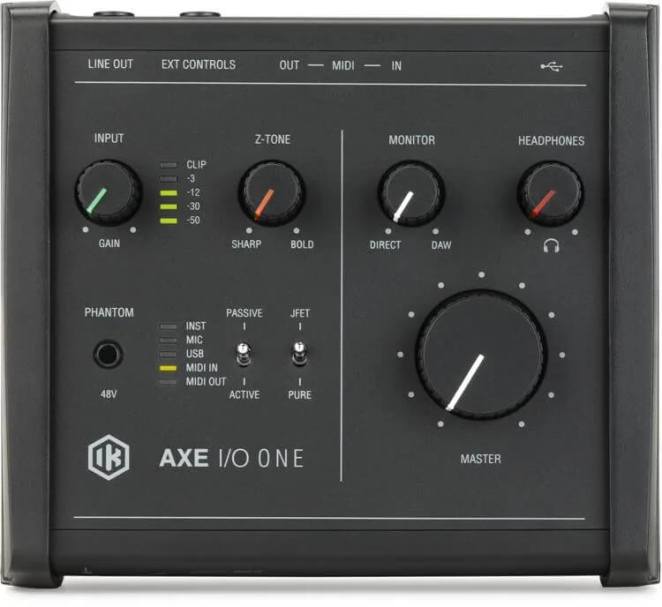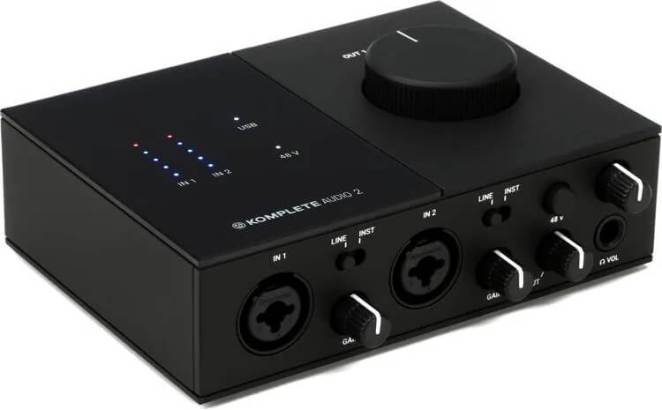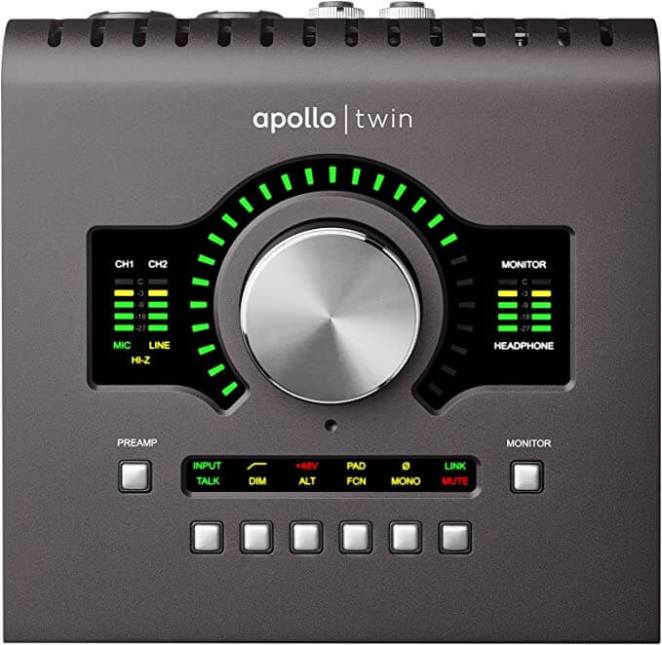When you buy through our links, we may earn an affiliate commission.
Guitar audio interfaces are an essential component in the modern guitarist's toolkit - but with so many audio interfaces to choose from, it can be hard to know which is the best for you. So we're here to help you choose.
The main purpose of using a guitar audio interface is to allow you to record your guitar playing on a digital audio workstation. That said, they can give you a range of other advantages.
In this guide, you'll discover some of the best guitar audio interface deals today and learn your unique needs to make certain models more suitable for you.
Overall, we think the best audio interfaces for guitarists are the IK Multimedia AXE I/O ONE and the Volt 176. These both offer high-quality components and features for guitarists without needing to spend a lot of money.
If you have a larger budget, then the UAD Apollo Twin MKII DUO is a top-end audio interface that is used by professionals.
These might not be for everybody though, so check out some of the other choices we share and the buyer's guide!
Quick Summary of the Best Guitar Audio Interfaces
- IK Multimedia AXE I/O ONE USB Guitar Audio Interface (Best for Small Budgets)
- Native Instruments Komplete Audio 2 USB Audio Interface (Ideal for Singer-Songwriters on a Budget)
- Universal Audio Volt 176 USB-C Audio Interface (For Analog Lovers)
- Solid State Logic SSL2+ USB Audio Interface (Best for Intermediate Recording)
- Focusrite Scarlett 4i4 (Excellent Flexibility)
- Multimedia AXE I/O SOLO 2x3 USB Guitar Audio Interface (For Powerful Guitar Recording)
- Universal Audio Apollo Twin MKII DUO Heritage Edition (For the Professionals)
Best Guitar Audio Interfaces
Here are the best guitar audio interfaces on the market today.
1. Best for Small Budgets – IK Multimedia AXE I/O ONE USB Guitar Audio Interface

SPECS
- Inputs: 1 x hybrid mic/Instrument
- Outputs: 3 = headphones, amp, and speakers
- Resolution: Up to 24-bit/192kHz
- Connection and Compatibility: USB-C, Mac, and Windows
- MIDI: In/Out
- Extras: AmpliTube 5 software
The AXE I/O One from IK Multimedia is a fantastic audio interface for any guitarist looking for a simple, affordable, but powerful setup. Despite being low cost, the AXE I/O ONE has a bunch of cool features and connections that make it an ideal tool for guitarists.
The inputs and outputs give some nice flexibility, which makes this interface a good choice for anybody who wants to use an amplifier and record guitar. It has some really nice guitar-focused features which you tend not to see in this price range.
Notable examples include the re-amp output, which makes it super easy to run your clean recordings back out into an amplifier, and then record the amp with a mic to get a nice analog tone.
It also has foot switch inputs and outputs, which let you connect controller pedals to the interface to control virtual pedals and amp software like Amplitude.
This interface includes a free download of Amplitude 5 software, which has a bunch of cool virtual amps and pedals to craft unique guitar tones directly from your PC. The resolution is high, and the preamps are well made, which results in high-quality guitar recordings without breaking the bank.
It might be slightly limited by only having one input - meaning you can only use it when working solo, and can’t capture stereo, but overall this is a fantastic product for the price.
This is a strong choice for beginners on a budget or guitarists wanting more guitar features while working in a small space.
2. Ideal for Singer-Songwriters on a Budget – Native Instruments Komplete Audio 2 USB Audio Interface

SPECS
- Inputs: 2x hybrid XLR/DI inputs, 48v Phantom Power
- Outputs: Stereo ¼”
- Resolution: 24-bit/192kHz
- Connection and Compatibility: USB Type B, Mac, and Windows
- MIDI: No
- Extras: Ableton Live Lite, Maschine Essentials, Komplete Start, iZotope Elements Suite
The Komplete Audio 2 from Native Instruments is another decent low-cost audio interface that is a strong contender for guitarists who are looking for their first entry into the home recording world.
This interface features a pair of hybrid inputs, each with a separate gain control. This means you can capture two guitars at once, one guitar and one mic, or two mics on an amplifier.
This gives you a decent amount of flexibility for a small recording setup. Two hybrid inputs like this will be enough to get creative with the recording process.
The overall design is clean and stylish, and it's small enough to carry around in your guitar bag without adding much weight. The recording volume meters are nice, too, letting you easily see the volume of the incoming signal and be alerted if it’s clipping.
It has an input/host mix, which lets you monitor the incoming signal with zero latency, which is a handy feature if you use a lot of plugins in your DAW (or are working on an older machine).
One of the most attractive features of this interface is the amount of bundled software downloads. You get a lot here - making this a great investment for newcomers to digital recording and music production.
3. For Analog Lovers – Universal Audio Volt 176 USB-C Audio Interface

SPECS
- Inputs: 1 x hybrid XLR/DI
- Outputs: 2x1/4” + Headphones
- Resolution: 24-bit/192kHz
- Connection and Compatibility: USB C, Mac, Windows, iOs
- MIDI: In/Out
- Extras: Built-in 1176 Compressor Sim, Vintage Preamp Mode, and Bundled Software (Ableton Live Lite, Melodyne Essential, UJAM, Softube Marshall, Plugin Alliance Ampeg, Relab LX480 Essentials)
The Universal Audio Volt range is a collection of more affordable interfaces from the industry titans Universal Audio.
UA is known for its uncompromising quality and pristine engineering; while most of its products are in the professional price range, its quality still shines through in these more affordable devices.
The Volt 176 is an excellent choice for guitarists looking for an interface with a little more spice and nuance than the above products. This interface is designed to offer a little more analog crispiness and color compared to others on this list.
Thanks to the built-in 1176 Compressor Simulation (which sounds gorgeous) and the Vintage Preamp Modeling (also tasty), you can achieve a super sweet tone directly from a raw recording without needing any extra processing.
It has a decent range of connections and includes a MIDI in/out for use with external gear, which is a useful inclusion. The headphone output and main outputs are very clean and have no noise. We also think the controls and knobs are super smooth and responsive - just like the input and output meters.
It only has one input, which is a little bit limiting for more complex setups. The Volt 276 is also a great choice if you need more input. As are the Volt 476 and Volt 476P, which have even more expansion and features.
The retro-inspired aesthetic is matched with a lovely collection of free software downloads and plugins, which help you craft an even sweeter tone and save you some bucks in the process.
In terms of quality to price, the UAD Volt series has some of the best products on offer in the market. You really won’t be disappointed with any of these.
4. Best for Intermediate Recording – Solid State Logic SSL2+ USB Audio Interface

SPECS
- Inputs: 2x hybrid XLR/DI
- Outputs: 2x headphones, 2 x stereo output pairs
- Resolution: 24-bit/192kHz
- Connection and Compatibility: USB C, Mac, and Windows
- MIDI: In/Out
- Extras: SSL Production Pack, Celemony Melodyne, IK Multimedia AmpliTube SE, Native Instruments Hybrid Keys, Ableton Live Lite, AAS Session Bundle plug-in
Solid State Logic (SSL) is another highly renowned company in the music gear industry and has been known to create many revolutionary devices throughout history.
They earned their badge of gear-production honor in the 1970s when they sold many innovative mixing desks and other hardware. This acclaimed heritage is represented in the relatively new SSL audio interface range, starting with the affordable SSL2+.
This has incredibly high-quality preamps that use the same circuitry as their multiple-thousand-dollar mixing desks. These produce truly stunning recordings, particularly when paired with a high-resolution mode.
One of the unique features of the SSL interface range is the inclusion of their magical ‘4K’ button. When engaged, this replicated the analog magic of their larger mixing consoles from the SSL 4000 series.
If you’re looking for a tasty bit of analog spice to mix into your recordings, then the 4K button is worth checking out.
Besides the delightful audio quality, the overall functionality and design of the interface are very good. It has a lot of handy features which make your guitar recording sessions easier and more intuitive.
A notable element is the two headphone outputs (for you and a friend) and a pair of stereo outputs, meaning you can run two monitoring setups from the interface. These features make the interface more flexible for recording multi-musician sessions.
If you don’t mind sacrificing some of the flexibility, the SSL2 Standard is also excellent and has the same audio quality.
Overall, this device is in the same league as the UAD Volt series and has competitive audio quality, extensive connectivity, and features to run smooth and manageable recording sessions.
5. Excellent Flexibility – Focusrite Scarlett 4i4

SPECS
- Inputs: 2 x hybrid XLR/DI, and 2 x ¼” DI line
- Outputs: 1 x headphones, 4 x ¼’ line
- Resolution: 24-bit/192kHz
- Connection and Compatibility: USB C, Mac, Windows
- MIDI: In/Out
- Extras: 3-month Pro Tools Artist Subscription, Ableton Live Lite, Hitmaker Expansion Bundle
Focusrite is a branch of Neve, which is a legendary British audio gear company. Their Focusrite series of audio interfaces have been incredibly popular over the last decade or two and have been satisfying the needs of musicians and recording artists at every corner of the music industry.
There are a bunch of Focusrite audio interfaces in the range, starting at the humble Scarlett Solo and going up to larger rack-mounted units, which are suitable for professional recording studios.
The 4i4 is a good mid-point in the Focusrite range. This device can accommodate a total of 4 inputs simultaneously, meaning that there is more than enough for a solo recording session. It has two hybrid XLR/DI inputs and two DI instruments, with dedicated mic preamps for the mic channels.
This means you could record two guitars directly while also having a mic on each of their amps or a stereo amp mic pair and two direct signals.
Or two guitarists with two vocalists or any other combination you can imagine. The choice is up to you, but this interface has enough input to give a decent amount of flexibility for recording.
The audio quality of the preamps is decent, and the preamps are equipped with switchable Focusrite Air circuits, which add a bit of extra clarity and crispness to the captured signal.
The Focusrite range offers great quality and functionality for the price and is another strong choice for any guitarist.
6. For Powerful Guitar Recording – IK Multimedia AXE I/O SOLO 2x3 USB Guitar Audio Interface

SPECS
- Inputs: 1 x hybrid XLR/DI, 1 x ¼” DI
- Outputs: 2 x ¼” Master, 1 x ¼” Amp Out
- Resolution: 24-bit/192kHz
- Connection and Compatibility: USB B, Mac, Windows
- MIDI: In/Out
- Extras: AmpliTube Deluxe, T-RackS Singles, Ableton Live Lite
IK Multimedia has a range of guitarist-friendly audio interfaces and products, and their AXE I/O Solo is a top contender. Any guitar player who wants something with a bit more flexibility and color than a basic interface will be pleased with the AXE Solo.
This interface has all the inputs and outputs you need for a solo guitarist or singer-songwriter to capture their ideas and performances in high quality.
One of the nice features is the switchable preamps, which can engage a JFET mode to add a bit more analog crunch and saturation to their incoming tone. They also have a switch to change between active and passive pickups, which is a nice bit of added flexibility.
Additionally, it has a good selection of outputs, including an AMP-Out, which can be connected to an amp to re-amp a guitar signal. You can switch between digital or direct monitoring, which gives you latency-free listening when you need to record.
A bunch of software is bundled with this device, including AmpliTube Deluxe and T-Racks Singles, which will give you more than enough digital firepower to level up your guitar tones.
This model is a little bit more expensive than others on this list, but it brings a bunch of handy features and tonal options that other interfaces don’t have. However, the number of inputs does make it slightly limited for larger recording sessions.
7. For the Professionals – Universal Audio Apollo Twin MKII DUO Heritage Edition

SPECS
- Inputs: 2 x hybrid XLR/DI, 10x Optical connector
- Outputs: 2 x Stereo Pairs ¼”
- Resolution: 24-bit/192kHz
- Connection and Compatibility: Thunderbolt 2, Mac, Windows
- MIDI: No
- Extras: Two built-in SHARC processors for real-time UAD plugins, UAD Analog Classics Bundle with Unison Emulations, 5 Heritage Edition plug-ins
The Universal Audio Apollo Twin is by far the nicest audio interface on this list in terms of quality, functionality, features, and design. Unfortunately, it’s also the most expensive. However, if you have the money, this is close to perfection.
The Apollo series of UAD interfaces have built-in DSP chips, meaning you can run UAD’s God-tier plugins in real-time while recording. This is a very desirable feature that is used by professionals all over the world.
You can achieve unreal levels of audio quality, which sounds like it was tracked through some of the finest pieces of analog gear.
The unit is a little chunkier and heavier than others here, but that adds a very satisfying, professional touch and is built to last. The preamps are pristine and beautiful, the functionality is incredibly professional, and the plugins are to die for.
This is a fantastic investment for any serious musician who wants to create top-level recordings.
Best Guitar Audio Interfaces Buyer's Guide
Here are some important things to consider when choosing a guitar audio interface to make sure you get the type you need.
Inputs and Outputs
You can find audio interfaces with any combination of inputs and outputs. As a guitarist, the bare minimum you will want is at least one instrument (TRS) input. This means you can plug the guitar directly into the interface for use with your recording software.
However, it can be useful to have more input to expand your creative possibilities.
If you want to record vocals at the same time, an interface with either 2 combo inputs or one XLR and one TRS input is a good choice, as this lets you plug a microphone and a guitar in at the same time. If you want to record a DI (direct input) signal and mic up an amp, then this is also a good choice.
Going for an interface with more instrument inputs gives you more futureproofing, as it may come to a point when you want to record a larger session with more instruments. However, if you are on a tight budget, then going for something with just enough to record one guitar should be fine.
As for outputs, this really depends on how you will be using the interface and what kind of inputs your speakers have. The main outputs are normally either RCA, 1/4", or XLR. So pick something that matches your speaker inputs. Also, headphone outputs are essential, but basically, every interface includes these.
Resolution (Sample Rate and Bit Depth)
Sample rate and bit depth are two core concepts within digital audio, and both define the final quality of any recording.
Most music is released with a sample rate of 44.1khz, which is the bare minimum that audio interfaces record at. However, if you want to record your audio with higher quality, then going for a device that offers something with 88.2 or 96kHz can give you a higher quality. This affects captured frequency detail.
As for bit depth, this determines the width of the dynamic range that the interface can capture. Most audio these days is released in 16-bit, although capturing your audio in higher bit depths does give you more flexibility and creative freedom.
It's a complicated thing to understand that is beyond the scope of this article, but we recommend going for a device that can capture audio with at least 24-bit depth.
Connections and Compatibility
These days, most interfaces are compatible with either Windows or Mac machines, although some are specifically designed for one or the other, so make sure you pick one that works for your machine.
The cable connection is another point of consideration. The majority of interfaces use a USB 2 connection, which is fine for most machines. Although a lot of modern Macs only have the smaller USB 3.0, which some audio interfaces have as a cable.
Again, check the ports on your computer and pick a device that has that type of connection output.
Portability
Some audio interfaces are larger than others. If you want to have an interface that you can use on the go, then pick a smaller portable audio interface that can fit in your bag.
However, larger interfaces tend to have more features but are better suited to being permanently installed in a studio and aren't particularly portable.
Frequently Asked Questions (FAQs)
Do you need an audio interface for guitar?
You will need an audio interface for guitar in certain situations, but not all the time. The main purpose of an audio interface is to record an audio signal into the computer. This lets you create music in a digital audio workstation.
Audio interfaces give you a bunch of other creative options and are useful practice tools. You can use them as a tuner, as a virtual amplifier, or to record your guitar to listen back to it.
Can you practice guitar with an audio interface?
You can practice guitar with an audio interface. In fact, they are a fantastic practice tool, and they will make a guitarist's life much easier. If you play electric guitar, you might think you need an amplifier to practice.
However, with an audio interface, all you need is your guitar, the interface, and a computer. You can run the guitar into the interact and use software to simulate any amp sound you can imagine. Any serious guitarist will find that an audio interface quickly becomes one of their most valuable tools.
Is Focusrite good for guitar?
Focusrite interfaces are pretty good for guitar. Focusrite is a subsidiary of Neve, which is one of the most highly regarded brands in the audio industry.
All the high-level design and manufacturing experience Neve has obtained is found in Focusrite products.
All of the Focusrite interfaces are a great choice for guitarists, as they have high recording quality and good functionality and features for guitarists.
Conclusion
Now you know the best audio interfaces for recording guitar and how to choose one, you'll have no problem finding your ideal piece of gear.
For most people, we recommend the IK Multimedia AXE I/O ONE and the Volt 176. As far as audio interfaces for guitarists go, you won't find anything better in their prospective price range.
However, if you want something a bit more professional, the UAD Apollo Twin MKII DUO is a serious bit of kit with unmatched quality.
Harmonize your music production setup effortlessly with our guide to the best Macs for music production, ensuring a seamless workflow for your artistic vision.
Enhance your sound quality! Discover the best audio interfaces for professional recordings—explore now!
Upgrade to professional sound quality with Behringer U-Phoria UMC202HD!
